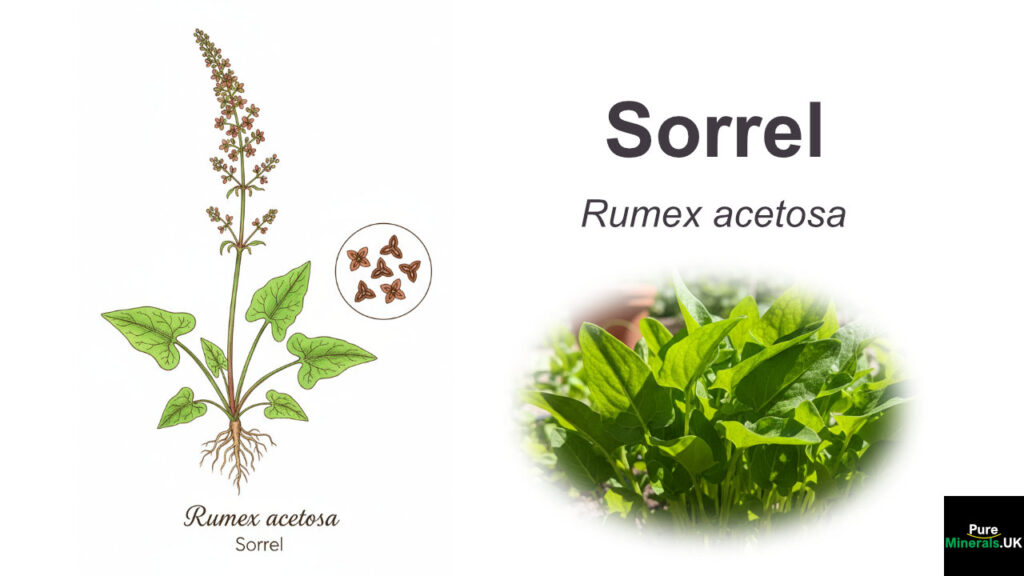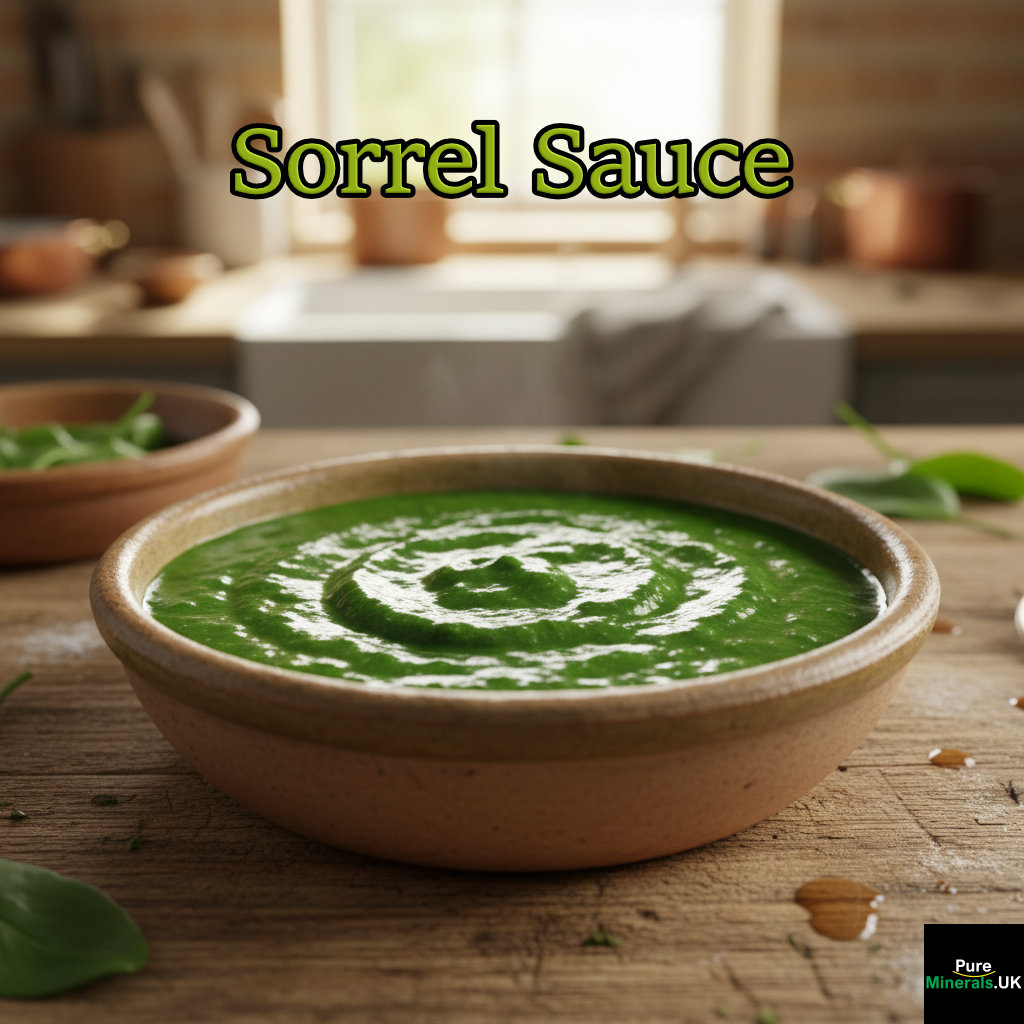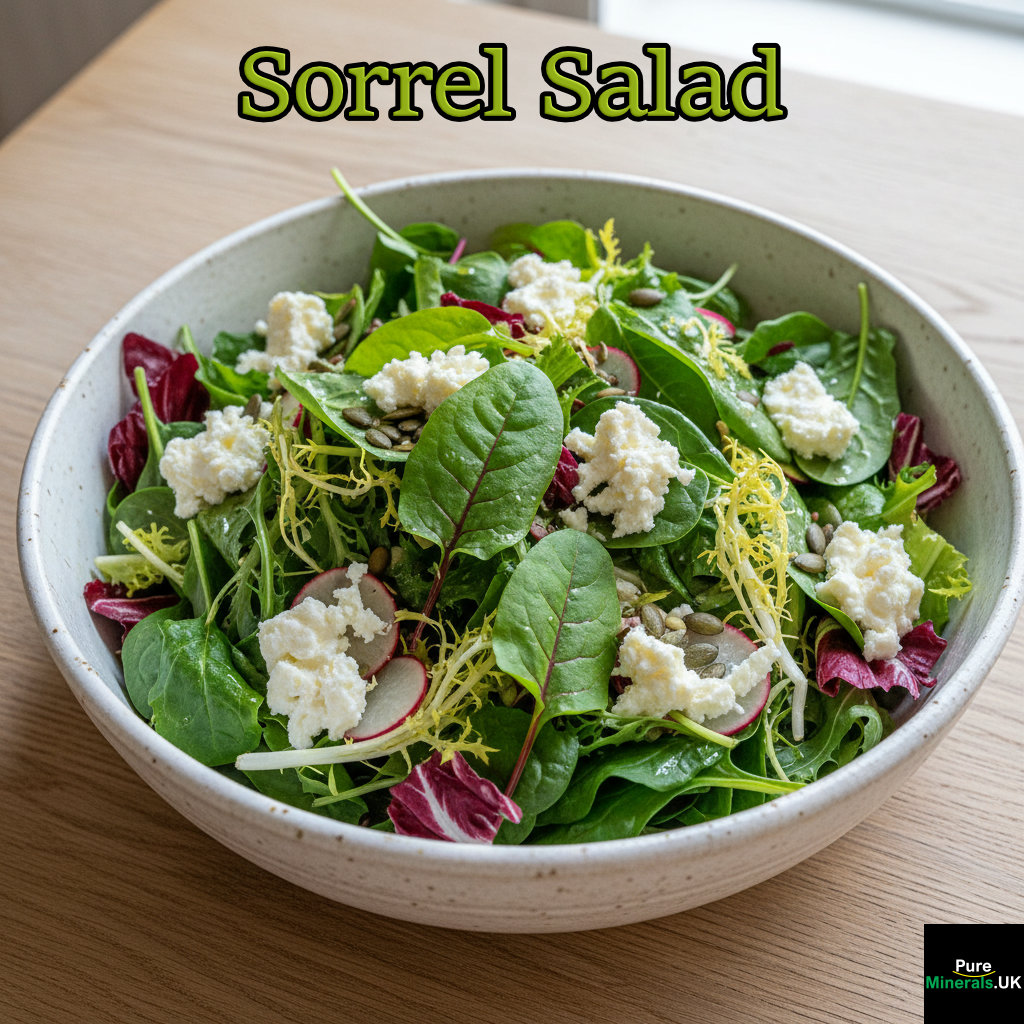
Key Takeaways
- Sorrel contains significantly more vitamin C than oranges, with one cup providing up to 106% of your daily recommended intake
- The tangy herb enhances immune function, promotes collagen production, and improves iron absorption due to its high vitamin C content
- Sorrel’s vitamin C remains most potent when the leaves are fresh and consumed raw or lightly cooked
- Spring is the optimal season for harvesting fresh sorrel with peak vitamin content
- People with kidney stones, gout, or rheumatoid arthritis should consume sorrel in moderation due to its oxalic acid content
Step aside, oranges – there’s a tangy green leaf that deserves the vitamin C crown. Sorrel, with its bright lemony flavor and impressive nutritional profile, delivers more immune-boosting vitamin C per serving than the citrus fruits we typically associate with this essential nutrient. While many health enthusiasts overlook this versatile herb, Nutrition United’s research shows it’s one of the most potent natural sources of vitamin C available during spring months.
Often mistaken for spinach at farmers’ markets, sorrel (Rumex acetosa) has been used for centuries both as a culinary ingredient and a medicinal herb across cultures. Its distinctly sour taste comes from oxalic acid – the same compound found in rhubarb – making it perfect for adding brightness to spring soups, salads, and sauces without additional lemon juice.

Article-at-a-Glance
Sorrel is a nutritional powerhouse that shines brightest in early spring when its vitamin C content peaks. This tangy herb contains a remarkable array of health-supporting nutrients, with vitamin C being the standout star. From boosting immunity to promoting radiant skin, sorrel’s benefits extend far beyond its unique flavor profile. Whether you’re looking to strengthen your immune system, enhance your body’s natural collagen production, or simply add a zesty kick to your meals, this often-overlooked green deserves a prominent place in your spring diet.
Sorrel’s Tangy Health Secret: More Vitamin C Than Oranges
The humble sorrel leaf packs an impressive nutritional punch, containing more vitamin C per serving than the citrus fruits most commonly associated with this essential nutrient. A single cup of fresh sorrel leaves contains approximately 64mg of vitamin C – that’s 106% of your recommended daily intake. This remarkable concentration exceeds that of oranges (which provide about 70mg per medium fruit) and positions sorrel as one of nature’s most potent sources of this vital vitamin.
The high vitamin C content in sorrel supports numerous physiological functions, from immune system regulation to collagen synthesis. What makes sorrel particularly valuable is that its vitamin C comes packaged alongside complementary phytonutrients that enhance absorption and effectiveness. Unlike isolated vitamin supplements, sorrel provides a complete nutritional matrix that allows your body to utilize vitamin C optimally.
“Sorrel contains approximately 1.7 times more vitamin C per gram than oranges, making it one of the richest natural sources of this essential nutrient. Its bioavailability is enhanced by the presence of flavonoids and other phytonutrients that work synergistically with vitamin C.” – Journal of Nutritional Biochemistry
Why This Lemony Green Outperforms Citrus
Sorrel’s vitamin C advantage extends beyond mere concentration numbers. Unlike citrus fruits, which contain primarily ascorbic acid, sorrel contains a more complex vitamin C profile that includes ascorbic acid, dehydroascorbic acid, and various vitamin C metabolites. This diversity of vitamin C forms contributes to sorrel’s superior antioxidant capacity and potential health benefits. Additionally, the natural bioflavonoids in sorrel help protect vitamin C from oxidation in the body, potentially extending its beneficial effects and improving cellular absorption. Discover more about natural bioflavonoids and their benefits.
Seasonal Availability: When to Find Fresh Sorrel
Sorrel reaches its nutritional peak during early spring, when young leaves emerge with the highest vitamin C concentration. This early spring harvest (typically March through May in most regions) coincides with a time when our bodies often need immune support after winter. The tender young leaves harvested during this period not only contain optimal vitamin levels but also offer the mildest flavor, making them ideal for both raw and cooked applications. As the season progresses into summer, sorrel leaves become increasingly acidic and their vitamin C content gradually diminishes, though they remain nutritionally valuable year-round in most climates.
6 Remarkable Health Benefits of Sorrel’s Vitamin C Content
The exceptional vitamin C content in sorrel delivers wide-ranging health benefits that extend from cellular protection to enhanced wound healing. This water-soluble vitamin serves as both a powerful antioxidant and an essential cofactor in numerous enzymatic reactions throughout the body. While many plants contain some vitamin C, sorrel’s particularly high concentration makes it especially valuable for supporting overall wellness, particularly during seasonal transitions when immune support is most needed. Regular consumption of sorrel-rich foods can contribute significantly to maintaining optimal vitamin C levels in the body.
1. Immune System Enhancement
Sorrel’s abundant vitamin C content provides crucial support for both innate and adaptive immune functions. This essential nutrient stimulates the production and function of white blood cells, particularly neutrophils, lymphocytes, and phagocytes, which are vital for defending against pathogens. Research indicates that adequate vitamin C intake can reduce the duration and severity of common infections, particularly respiratory illnesses.
Beyond supporting white blood cell function, the vitamin C in sorrel enhances the skin’s barrier function, providing the first line of defense against environmental pathogens. It also promotes the production of interferon, an important signaling molecule that coordinates immune responses against viruses and other threats. During periods of stress or illness, the body’s vitamin C requirements increase substantially, making vitamin C-rich foods like sorrel especially valuable.
Regular consumption of sorrel can help maintain optimal immune vigilance without overstimulating inflammatory responses. This balanced immune support is particularly beneficial during seasonal transitions when viral exposure typically increases. Many holistic health practitioners recommend increasing sorrel intake at the first signs of illness to support the body’s natural defense mechanisms.
2. Collagen Production for Skin Health
Vitamin C plays an indispensable role in collagen synthesis, making sorrel a natural ally for skin health and elasticity. As a required cofactor for the enzymes responsible for stabilizing collagen molecules, vitamin C ensures proper formation of this structural protein that keeps skin firm and resilient. Without adequate vitamin C, collagen production falters, potentially leading to premature skin aging, poor wound healing, and compromised skin integrity.
Regular consumption of sorrel can help maintain optimal collagen levels throughout the body. This supports not just facial skin but also the skin covering your entire body, blood vessels, tendons, ligaments, and even bone matrix. Many dermatologists now recommend dietary sources of vitamin C alongside topical treatments for comprehensive skin care approaches that work from the inside out.
The bioflavonoids naturally present in sorrel enhance the skin benefits of vitamin C by protecting it from oxidation and supporting blood vessel health, which improves nutrient delivery to skin cells. This combination makes sorrel particularly effective for maintaining a healthy, radiant complexion compared to isolated vitamin C supplements.
3. Iron Absorption Improvement
One of vitamin C’s lesser-known but crucial functions is enhancing iron absorption, particularly non-heme iron from plant sources. Sorrel creates the perfect nutritional pairing by providing both vitamin C and iron in the same leaf. This combination helps convert dietary iron into a more absorbable form, potentially increasing absorption rates by up to 300%.
For those following plant-based diets or struggling with iron deficiency, incorporating sorrel into meals containing iron-rich foods like lentils, beans, or spinach creates a powerful nutritional synergy. The enhanced iron absorption supported by sorrel’s vitamin C content helps transport oxygen throughout the body, prevents fatigue, and supports cognitive function.
4. Antioxidant Protection
The vitamin C in sorrel functions as a powerful antioxidant, neutralizing harmful free radicals before they can damage cells, proteins, and DNA. This protective action helps shield the body from oxidative stress, which has been implicated in numerous chronic health conditions and accelerated aging. What makes sorrel particularly valuable is that its antioxidant benefits extend beyond vitamin C alone.
Sorrel contains a complex array of antioxidant compounds, including flavonoids, polyphenols, and vitamin C, that work synergistically to provide comprehensive cellular protection. Research suggests that this antioxidant network may help protect against inflammation, cardiovascular issues, and cellular changes associated with chronic disease. For those seeking to boost their body’s natural defense systems, few foods offer the antioxidant diversity of fresh sorrel leaves.
5. Wound Healing Acceleration
Vitamin C accelerates the healing process by supporting collagen formation at wound sites and enhancing immune cell migration to areas needing repair. Sorrel’s rich vitamin C content makes it particularly valuable for recovery from injuries, surgeries, or skin damage. Historical medical texts often mentioned sorrel poultices for wound treatment, suggesting our ancestors recognized its healing properties long before understanding the science behind them.
Beyond topical applications, consuming vitamin C-rich sorrel supports internal healing processes as well. From digestive tissue repair to vascular healing, adequate vitamin C ensures that the body can efficiently regenerate damaged tissues. For those recovering from illness or injury, incorporating sorrel into the diet may help speed recovery and strengthen healing tissues.
Beyond Vitamin C: Other Nutritional Treasures in Sorrel
While vitamin C rightfully captures attention as sorrel’s standout nutrient, this tangy leaf contains an impressive array of other beneficial compounds that contribute to its health-promoting properties. From essential minerals to unique phytochemicals, sorrel offers comprehensive nutritional support that extends well beyond its vitamin C content. Understanding this broader nutritional profile helps explain why traditional healing systems have valued sorrel for centuries before vitamins were even discovered.
Essential Minerals in Sorrel Leaves
Sorrel provides significant amounts of potassium, magnesium, and iron – minerals often lacking in modern diets. A single cup of fresh sorrel leaves contains approximately 15% of the recommended daily intake for potassium, which helps regulate blood pressure and fluid balance. The magnesium content supports over 300 enzymatic reactions in the body, including energy production and nervous system function, while the iron helps prevent anemia and fatigue.
Additionally, sorrel contains trace minerals like manganese, copper, and zinc that serve as cofactors for antioxidant enzymes, further enhancing its protective benefits. This mineral content makes sorrel particularly valuable for supporting electrolyte balance during warm weather months when the tangy leaves are most abundant and refreshing.
See our Shop for how to get the full spectrum (>70) of 100% pure plant-derived prehistoric hydrophilic minerals and trace minerals — much, much more than is available in modern-day foods grown on mineral-depleted farm soils.
Antioxidant Compounds and Their Effects
Beyond vitamin C, sorrel contains numerous phytochemicals with demonstrated antioxidant and anti-inflammatory properties. These include flavonoids like quercetin and kaempferol, anthocyanins, and various polyphenolic compounds that work synergistically to protect cells from oxidative damage. Research suggests these compounds may help modulate inflammatory pathways and support cardiovascular health.
Particularly noteworthy is sorrel’s content of chlorogenic acid, a phenolic compound associated with blood sugar regulation and weight management in some studies. This complex phytochemical profile explains why whole-food sources of nutrients like sorrel typically offer greater health benefits than isolated nutrient supplements.
Nutrient | Amount per 1 cup (133g) | % Daily Value | Health Benefits |
|---|---|---|---|
Vitamin C |
64 mg |
106% |
Immune support, collagen production, antioxidant protection |
Vitamin A |
3990 IU |
80% |
Vision health, immune function, and cellular growth |
Potassium |
519 mg |
15% |
Blood pressure regulation, fluid balance, nerve function |
Iron |
2.7 mg |
15% |
Oxygen transport, energy production, and cognitive function |
Magnesium |
54 mg |
13% |
Muscle and nerve function, energy production, and bone health |
Important Cautions About Sorrel Consumption
Despite its impressive nutritional profile, sorrel should be consumed with certain precautions in mind. The same compounds that give sorrel its distinctive tangy flavor – primarily oxalic acid – can pose challenges for individuals with specific health conditions. Understanding these limitations helps ensure you can enjoy sorrel’s benefits while minimizing potential risks. Always consult with a healthcare provider if you have concerns about incorporating new foods into your diet, especially if you have existing health conditions. For those interested in exploring other herbs, consider reading about oregano and its health benefits.
Oxalic Acid Content and Who Should Limit Intake
Sorrel contains significant amounts of oxalic acid, a naturally occurring compound that can bind to minerals like calcium and potentially contribute to kidney stone formation in susceptible individuals. People with a history of calcium oxalate kidney stones, gout, rheumatoid arthritis, or certain digestive disorders may need to moderate their sorrel consumption. The oxalic acid concentration is highest in mature summer leaves and decreases somewhat with cooking.
Pregnant women should consume sorrel in moderation, as excessive oxalic acid intake might potentially affect mineral absorption. For most healthy adults, however, moderate sorrel consumption as part of a varied diet poses minimal concerns. Pairing sorrel with calcium-rich foods can help mitigate potential mineral-binding effects, as can blanching the leaves briefly before using them in recipes.
Medication Interactions to Watch For
Sorrel’s high vitamin C content and natural compounds may interact with certain medications. Those taking blood thinners like warfarin should maintain a consistent intake of vitamin C-rich foods, including sorrel, as sudden changes could potentially affect medication efficacy. Similarly, individuals taking diuretics or medications for high blood pressure should be aware that sorrel’s potassium content might enhance these effects.
Sorrel may also affect the absorption of certain antibiotics, particularly tetracyclines and quinolones. For maximum medication effectiveness, it’s advisable to separate sorrel consumption from antibiotic dosing by at least two hours. As with any food that may interact with medications, consult your healthcare provider about specific guidelines related to your medication regimen.
Why Sorrel Deserves a Place in Your Spring Garden

Few perennial vegetables offer the combination of culinary versatility, nutritional density, and ease of cultivation that sorrel provides. As one of the earliest greens to emerge in spring, sorrel can provide vital nutrients precisely when the body is transitioning from winter and needs immune support. A small patch of garden sorrel will reliably produce harvestable leaves for many years with minimal maintenance, making it an excellent investment for home gardeners interested in nutritional self-sufficiency.
Beyond practical considerations, sorrel adds distinctive beauty to edible landscapes with its arrow-shaped leaves and delicate red flower stalks that emerge in late spring. Its ability to thrive in partial shade makes it versatile for various garden locations, and its perennial nature means less work replanting each year. For those looking to maximize nutrient density per square foot of garden space, few plants can match sorrel’s vitamin C production throughout the growing season.
Easy Growing Tips for Beginners
Sorrel thrives in well-drained soil with a slightly acidic to neutral pH between 5.5 and 6.8. Start seeds indoors 4-6 weeks before the last frost, or direct sow once soil can be worked in early spring. Plants prefer a location with morning sun and afternoon shade in warmer climates, though they can handle full sun in cooler regions. Once established, sorrel requires minimal care beyond occasional watering during dry spells and dividing crowns every 3-4 years to maintain vigor and prevent overcrowding. Its natural pest resistance makes it particularly suitable for organic gardening methods, with few insects showing interest in the tangy leaves.
Harvesting for Maximum Vitamin Content
To capture sorrel’s peak vitamin C content, harvest young leaves in early morning hours when their nutritional density reaches its daily maximum. The youngest, tenderest leaves generally contain the highest concentration of vitamins and the mildest flavor, making them ideal for raw applications. Harvest by cutting outer leaves at the base while leaving the central growing point intact to ensure continuous production throughout the season. Remove flower stalks promptly when they appear to redirect the plant’s energy into leaf production and prevent self-seeding, which can lead to unwanted spread throughout the garden. For more herbal gardening tips, explore the benefits of oregano in your garden.
3 Sorrel Recipes
1. Sorrel Soup

Below is a classic sorrel soup that’s bright, tangy, and comforting. It’s easy to make with or without meat.
Serves: 4–6
Ingredients (classic version with broth)
- Sorrel leaves: 2 cups tightly packed, chopped (about 80–100 g)
- Potatoes: 2 medium, peeled and diced
- Onion: 1 small, finely chopped
- Butter: 2 tablespoons
- All-purpose flour: 1–2 tablespoons (optional for a light roux)
- Chicken or beef broth: 4 cups (1 liter), or water with bouillon
- Hard-boiled eggs: 2, peeled and chopped (optional garnish)
- Sour cream: 1/2 cup (for serving; optional)
- Fresh dill: 2 tablespoons, chopped (optional)
- Salt and pepper to taste
- Optional tang: a splash of lemon juice or white vinegar to taste
- Optional meat: 1 cup cooked shredded chicken or beef (if you want a meatier soup)
Ingredients (vegetarian/vegan variation)
- Omit the eggs and sour cream, or use vegan alternatives.
- Use vegetable broth instead of meat broth.
- For extra creaminess, blend a portion of the potatoes with some broth and return to the pot.
Instructions
- Prep the greens and potatoes:
- Rinse sorrel well, trim tough stems, and finely chop.
- Peel and dice potatoes.
- Chop onion.
- Start the base:
- In a large pot, melt the butter over medium heat.
- Add onion and sauté until translucent, about 3–4 minutes.
- Add potatoes:
- Stir in the diced potatoes and pour in the broth (or water with bouillon).
- Bring to a gentle boil, then reduce heat and simmer until potatoes are nearly tender, about 10–12 minutes.
- Add sorrel (and optional roux):
- If you’re using a roux for a touch of thickness, whisk flour into a small amount of melted butter in a separate pan until pale, then stir into the soup.
- Add the chopped sorrel to the pot. Simmer 3–5 minutes until the greens are wilted and bright green. Do not boil too long, or the sorrel can turn dull and lose its lively tang.
- Finish and season:
- Season with salt and pepper to taste.
- If desired, add a splash of lemon juice or vinegar to brighten the tang.
- Stir in chopped eggs and dill (if using). If you added meat, fold in shredded meat at this point and warm through briefly.
- Serve:
- Ladle into bowls and top with a dollop of sour cream (if using) and a bit more dill.
- Serve with crusty bread or rye toast.
Storage and tips
- Reheats well; store in the fridge for 2–3 days. Reheat gently to preserve the greens’ color.
- Sorrel can darken if overcooked. Add it near the end for the best bright green color and sharp flavor.
- For a purer green flavor, you can puree a portion of the potatoes with some broth and whisk it back into the pot.
2. Sorrel Sauce

Below is a rich Sorrel Cream Sauce using heavy cream, butter, sorrel, and stock. It’s bright-tart from the sorrel with a luxurious finish.
Serves: 4 Total time: about 25–30 minutes
Ingredients
- Butter: 2–3 tablespoons
- Shallot or small onion: 1, finely minced (or substitute with 1 small leek)
- Garlic: 1 clove, minced (optional)
- Sorrel leaves: 2 cups tightly packed, chopped (about 60–80 g)
- Stock: 1 cup (chicken or vegetable; use more or less to adjust thickness)
- Heavy cream: 1 cup (240 ml)
- Salt and white pepper to taste
- Lemon juice or white wine vinegar: 1 teaspoon (optional, to brighten)
- Fresh herbs for garnish (optional): chives, dill, or parsley
- Optional thickener (choose one):
- Roux method: 1 tablespoon all-purpose flour (to make a thicker sauce)
- Slurry method: 1 teaspoon cornstarch whisked with 1 tablespoon cold water (for a lighter thickening)
Instructions
- Prep greens and aromatics:
- Rinse sorrel, remove tough stems, and roughly chop.
- Mince shallot and garlic (if using).
- Start the base:
- In a saucepan, melt the butter over medium heat.
- Add shallot (and garlic, if using) and sauté 2–3 minutes until translucent and fragrant.
- Add sorrel:
- Add the chopped sorrel and cook 1–2 minutes until it’s wilted and bright green.
- Thicken (choose one method):
- No-thickener (quick and silky):
- Stir in stock and cream. Bring to a gentle simmer.
- Simmer 6–8 minutes, stirring occasionally, until slightly reduced and creamy.
- Roux method (for a richer, thicker sauce):
- If using a roux, add 1 tablespoon flour to the butter and cook 1–2 minutes to remove the raw flour taste.
- Gradually whisk in stock and cream; simmer until thickened, about 5–7 minutes.
- Slurry method (light thickening):
- Stir in stock and cream, bring to a simmer.
- Add the cornstarch slurry and cook 1–2 minutes until the sauce thickens.
- No-thickener (quick and silky):
- Finish and season:
- Season with salt and white pepper to taste.
- If you like a brighter note, whisk in a teaspoon of lemon juice or a splash of white wine vinegar.
- For extra gloss and richness, whisk in a tablespoon or two of cold butter at the end (optional).
- Optional texture adjustments:
- For a ultra-smooth sauce, blend briefly with an immersion blender or pass through a fine sieve.
- If you prefer a chunkier, more rustic sauce, keep it as is.
- Serve:
- Spoon over grilled or poached fish, chicken, or pasta.
- Garnish with chopped fresh herbs if desired.
Tips
- Sorrel color stays brightest if you don’t overcook it. Add sorrel toward the end of cooking.
- If you want a lighter green color, skip the roux and keep to the 1:1 cream-to-stock ratio.
- Vegetarian option: use vegetable stock and skip any meat-based additions.
3. Mixed Leaf Salad with Sorrel and Creamy Goat Cheese

Below is a bright, spring-inspired Mixed Leaf Salad with Sorrel and Creamy Goat Cheese.
Serves: 4 Total time: 15–20 minutes
Ingredients
- Mixed spring greens: 6–8 cups (baby spinach, arugula, butter lettuce, etc.)
- Sorrel leaves: 1 cup, finely torn or chopped
- Radishes: 4–6 thinly sliced (optional for crunch)
- Goat cheese: 4 oz (115 g) high-fat, soft goat cheese
- Heavy cream: 2–3 tablespoons (optional, to make the goat cheese topping creamy)
- Extra-virgin olive oil: 3–4 tablespoons
- Lemon juice: 1 tablespoon (freshly squeezed)
- Dijon mustard: 1 teaspoon
- Honey or maple syrup: 1/2 teaspoon (optional, balances acidity)
- Salt and white pepper to taste
- Optional garnishes: toasted nuts (walnuts or almonds), fresh herbs (chives, dill, or parsley)
Creamy goat cheese topping (optional but recommended)
- If you want a true “creamy topping,” whisk the goat cheese with the heavy cream until smooth and fluffy. Add a pinch of salt to taste.
Instructions
- Prep greens and sorrel
- Rinse greens and sorrel well, then dry thoroughly.
- Tear or chop greens into bite-sized pieces and roughly chop sorrel.
- Make the dressing
- In a small bowl, whisk together lemon juice, Dijon, honey (if using), salt, and pepper.
- Slowly drizzle in olive oil while whisking to emulsify.
- Prepare the creamy goat cheese
- If using the creamy topping: beat the goat cheese with the heavy cream until smooth and fluffy. Add a pinch of salt.
- Assemble
- In a large bowls, toss greens and sorrel with dressing until evenly coated.
- Scatter radishes over the top (if using).
- Spoon or dollop the creamy goat cheese over the salad.
- Finish and serve
- Garnish with toasted nuts and fresh herbs if desired.
- Serve immediately with crusty bread or as a side dish.
Tips and variations
- For extra texture, add sliced apples or pear and toasted nuts.
- If you prefer a purer green without cheese, use a light lemony vinaigrette and crumble the goat cheese on top just before serving.
- To keep greens vibrant, dress just before serving and avoid overdressing.
Frequently Asked Questions
As interest in nutritionally dense foods grows, questions about incorporating sorrel into modern diets have become increasingly common. Many people remain unfamiliar with this traditional vegetable despite its impressive nutritional profile and culinary versatility. The following questions address the most common inquiries about sorrel’s vitamin content, preparation methods, and potential health benefits.
Understanding these practical aspects of sorrel usage can help you maximize its nutritional benefits while enjoying its unique flavor profile. Whether you’re growing sorrel in your garden or purchasing it from farmers’ markets, these insights will help you make the most of this vitamin C-rich green.
Can I eat sorrel leaves raw or should they always be cooked?
Sorrel leaves can absolutely be eaten raw, particularly young, tender spring leaves which offer the mildest flavor and highest vitamin C content. Raw sorrel maintains 100% of its vitamin C, making fresh applications nutritionally superior. Consider adding young sorrel leaves to salads, using them as a garnish, or incorporating them into cold soups. If the tangy flavor proves too intense when raw, try mixing sorrel with milder greens or using it as you would fresh herbs rather than as the primary salad green.
How does sorrel’s vitamin C content compare to other leafy greens?
Sorrel substantially outperforms most common leafy greens in vitamin C content. With approximately 64mg per cup, sorrel contains nearly three times more vitamin C than kale (which provides about 22mg per cup), and significantly more than spinach (which offers approximately 8mg per cup). This exceptional vitamin concentration places sorrel among the elite leafy vegetables for vitamin C, surpassed only by specialized greens like certain mustard varieties.
The vitamin C advantage becomes particularly significant during winter-to-spring transitions when locally grown fresh produce options may be limited. During early spring, when sorrel emerges before many other garden greens, it can serve as a crucial source of vitamin C after winter months of potentially depleted stores.
Beyond total content, research suggests sorrel’s vitamin C may have superior bioavailability compared to some other greens due to its unique phytochemical profile. The flavonoid compounds in sorrel appear to protect vitamin C from oxidation during digestion, potentially enhancing absorption.
- Sorrel: 64mg vitamin C per cup (106% DV)
- Kale: 22mg vitamin C per cup (37% DV)
- Spinach: 8mg vitamin C per cup (13% DV)
- Romaine lettuce: 6mg vitamin C per cup (10% DV)
- Arugula: 3mg vitamin C per cup (5% DV)
Does cooking sorrel destroy its vitamin C content?
Cooking does reduce sorrel’s vitamin C content, as heat, water, and oxidation all contribute to vitamin C degradation. Brief cooking methods like quick blanching or wilting may preserve approximately 60-70% of the original vitamin C, while extended cooking in soups or stews might retain only 30-50%. The water-soluble nature of vitamin C means that boiling results in significant losses as vitamins leach into cooking water.
To maximize vitamin retention when cooking sorrel, opt for methods that minimize heat exposure and water contact. Quick steaming, stir-frying, or adding sorrel to dishes at the last possible moment helps preserve more of its nutritional value. When making traditional sorrel soups, consider adding a portion of fresh, raw sorrel leaves as a garnish just before serving to boost the vitamin C content of the finished dish.
- Raw sorrel: 100% vitamin C retention
- Briefly wilted (1-2 minutes): 70-80% retention
- Steamed (3-5 minutes): 60-70% retention
- Simmered in soup (10+ minutes): 30-50% retention
- Prolonged cooking (30+ minutes): 10-30% retention
Despite some vitamin loss during cooking, cooked sorrel remains nutritionally valuable and offers culinary possibilities that raw sorrel cannot. The cooking process also reduces oxalic acid content, which may benefit those sensitive to this compound.
Is wild sorrel the same as garden sorrel in terms of nutritional value?
Wild sorrel (often sheep sorrel, Rumex acetosella) typically contains higher concentrations of both beneficial nutrients and potentially problematic compounds compared to cultivated garden sorrel (Rumex acetosa). Research suggests wild sorrel may contain up to 30% more vitamin C, along with higher levels of certain antioxidant compounds, reflecting the plant’s need to produce protective phytochemicals in response to environmental stressors. However, wild sorrel also generally contains more oxalic acid, which necessitates greater caution for those with kidney stone histories or certain health conditions.
Can I freeze sorrel to preserve its vitamin content for later use?
Freezing is one of the best methods for preserving sorrel’s vitamin C content outside of its growing season. Blanching sorrel leaves for 30 seconds before freezing helps preserve color, texture, and nutrient content by deactivating enzymes that would otherwise degrade nutrients during storage. After blanching, immediately cool leaves in ice water, drain thoroughly, and pack in airtight containers or freezer bags with air removed. For more on preserving herbs, check out how to store parsley effectively.
Properly frozen sorrel retains approximately 70-80% of its original vitamin C content for up to six months. The frozen leaves work excellently in cooked applications like soups, sauces, and stews, though the texture change makes them less suitable for raw uses after thawing. Another preservation option is creating sorrel purée with a small amount of lemon juice (which helps prevent oxidation of vitamin C) before freezing in ice cube trays for convenient portioning.
For the absolute highest vitamin retention, consider freeze-drying sorrel if you have access to this technology. Commercial freeze-dried sorrel can retain up to 90% of original vitamin C content for extended periods. Alternatively, making and freezing sorrel pesto with olive oil creates a protective barrier against oxidation while preserving much of the nutritional value.
Sorrel is a versatile and tangy leaf that is perfect for adding a burst of flavor to spring soups. Rich in Vitamin C, it not only enhances the taste but also boosts the nutritional value of your meals. For those who love experimenting with herbs, incorporating a dash of rosemary can complement the tartness of sorrel beautifully.
